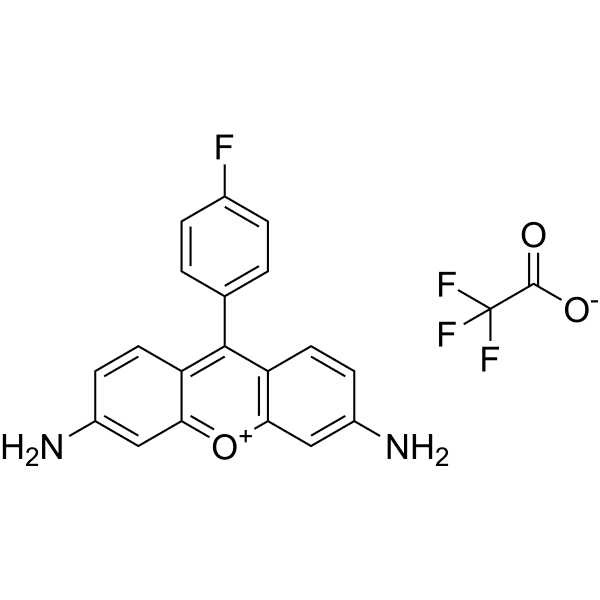All AbMole products are for research use only, cannot be used for human consumption.

For this product's availability, delivery time and price, please email [email protected] directly or click the "Inquiry Now" button below.
Kyoto probe 1 is a hiPSCs fluorescent probe. Kyoto probe 1 selectively labels human pluripotent stem cells. Kyoto probe 1 is primarily explained by the distinct expression patterns of ATP-binding cassette (ABC) transporters by hiPS cells and differentiated cells. Kyoto probe 1 (KP-1) rapidly distinguishes between human ES/iPS (hES/iPS) cells and their differentiated cells.
KP-1 is a fluorescent imaging probe that detects live human pluripotent stem cells in distinction from for detection of differentiated cells. KP-1 is permeable through the cell membrane and localize on the mitochondrial membrane by adding the probe to the culture medium.KP-1 is considered to be eliminated from the inside of the differentiated cells by the ABCtransporters which do not work in the pluripotent stem cells.
515 nm is suited for excitation wavelength. The wavelength of maximum emission is around 529 nm.
Procedure (for reference only)
1) Plate human iPS cells on the layer of the SNL feeder cells. Colonies of iPS cell are formed about 5 days after the plating.
Caution : Glass bottom dish etc. are recommended as cell culture dish, because it shows a low autofluorescence.
2) Dissolve 10 μg of KP-1 (1 vial) in 4.8 μL of DMSO to prepare 5 mM stock solution.
Caution : You are able to solve KP-1 in PBS (pH7.4) at the concentration of 0.25 mg/mL or below, if you do not want to use DMSO.
3) Dilute the DMSO stock solution with iPS culture medium to 2 µM cell stain solution.
4) Add stain solution to the dish and incubate for 3 hours.
5) Replacing the buffer to the iPS culture medium or HBSS and observe the cells using a fluorescence microscopy.
| Molecular Weight | 418.34 |
| Formula | C21H14F4N2O3 |
| CAS Number | 2088021-81-0 |
| Solubility (25°C) | DMSO 5 mM |
| Storage | -20°C, protect from light, dry, sealed |
[2] Nao Hirata, et al. Cell Rep. A chemical probe that labels human pluripotent stem cells
| Related Fluorescent Dye Products |
|---|
| pH Fluorescent Probe Red 600, SE
pH Fluorescent Probe Red 600, SE is a pH-sensitive fluorescent dye, the fluorescence intensity changes significantly with changes in the pH of the environment. pH Fluorescent Probe Red 600, SE is weakly fluorescent outside the cells, but its fluorescence is significantly enhanced in acidic compartments (such as phagosomes, lysosomes and endosomes). It can be used for multiplexing cellular functional analysis with green dyes such as GFP, Fluo-8, calcein, or FITC-labeled antibodies. Ex (nm) 576, Em (nm) 597 |
| DSPE-Rhodamine
DSPE-Rhodamine is formed by the conjugation of DSPE with the Rhodamine fluorescent dye. DSPE possesses a hydrophobic lipid tail and a hydrophilic head group, while Rhodamine is a red fluorescent dye. DSPE-Rhodamine retains the lipid properties of DSPE while also imparting fluorescent labelling capabilities. As a key component of delivery systems, DSPE-Rhodamine enhances targeting and bioavailability. Its lipid properties facilitate the penetration of molecules through cell membranes, while its fluorescent properties enable tracking of distribution and dynamic changes within the body. |
| LD540
LD540 is a novel high-sensitivity lipophilic dye modified with BODIPY fluorescent groups, designed for precise labelling and imaging of lipid droplets. LD540 exhibits excellent photostability and an optimal fluorescence spectrum, making it compatible with various commonly used fluorescent dyes (such as DAPI and Alexa Fluor 647), thereby supporting multi-colour imaging requirements. Additionally, LD540 is suitable for both fixed and live cells and can label ultra-small lipid droplets. |
| PDMPO
PDMPO (Yellow/Blue DND-160) is a ratiometric probe for the determination of lysosomal pH for fluorescence imaging. PDMPO exhibits pH-dependent dual excitation and dual emission peaks. PDMPO produces blue fluorescence (Ex/Em=329 nm/440 nm) in weakly acidic organelles, and in more acidic lysosomes it becomes yellow fluorescence (Ex/Em=384 nm/540 nm). |
| Copper probe CF4
Copper probe CF4 (Copper fluor CF4) is a Cu+-specific fluorescent probe based on a rhodol dye scaffold. Copper probe CF4 (Copper fluor CF4) has high copper selectivity with a Kd value of 2.9×10-13 M, particularly over zinc and iron, as well as abundant cellular alkali and alkaline earth metals. Copper probe CF4 (Copper fluor CF4) is stable in a physiologically relevant pH regime between 6 and 8 (wavelengths of 415 nm for excitation and 660 nm for emission). Copper probe CF4 (Copper fluor CF4) can be used to study colon cancer. |
All AbMole products are for research use only, cannot be used for human consumption or veterinary use. We do not provide products or services to individuals. Please comply with the intended use and do not use AbMole products for any other purpose.


Products are for research use only. Not for human use. We do not sell to patients.
© Copyright 2010-2024 AbMole BioScience. All Rights Reserved.
